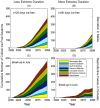Projected polar bear sea ice habitat in the Canadian Arctic Archipelago
- PMID: 25426720
- PMCID: PMC4245219
- DOI: 10.1371/journal.pone.0113746
Projected polar bear sea ice habitat in the Canadian Arctic Archipelago
Abstract
Background: Sea ice across the Arctic is declining and altering physical characteristics of marine ecosystems. Polar bears (Ursus maritimus) have been identified as vulnerable to changes in sea ice conditions. We use sea ice projections for the Canadian Arctic Archipelago from 2006 - 2100 to gain insight into the conservation challenges for polar bears with respect to habitat loss using metrics developed from polar bear energetics modeling.
Principal findings: Shifts away from multiyear ice to annual ice cover throughout the region, as well as lengthening ice-free periods, may become critical for polar bears before the end of the 21st century with projected warming. Each polar bear population in the Archipelago may undergo 2-5 months of ice-free conditions, where no such conditions exist presently. We identify spatially and temporally explicit ice-free periods that extend beyond what polar bears require for nutritional and reproductive demands.
Conclusions/significance: Under business-as-usual climate projections, polar bears may face starvation and reproductive failure across the entire Archipelago by the year 2100.
Conflict of interest statement
Figures




References
-
- Stroeve JC, Kattsov V, Barrett A, Serreze M, Pavlova T, et al. (2012) Trends in Arctic sea ice extent from CMIP5, CMIP3 and observations. Geophysical Research Letters 39.
-
- Maslanik JA, Fowler C, Stroeve J, Drobot S, Zwally J, et al. (2007) A younger, thinner Arctic ice cover: Increased potential for rapid, extensive sea-ice loss. Geophysical Research Letters 34.
-
- Comiso JC (2012) Large Decadal Decline of the Arctic Multiyear Ice Cover. Journal of Climate 25: 1176–1193.
-
- Arrigo KR, van Dijken G, Pabi S (2008) Impact of a shrinking Arctic ice cover on marine primary production. Geophysical Research Letters 35.
-
- Bluhm BA, Gradinger R (2008) Regional variability in food availability for arctic marine mammals. Ecological Applications 18: S77–S96. - PubMed
Publication types
MeSH terms
LinkOut - more resources
Full Text Sources
Other Literature Sources

